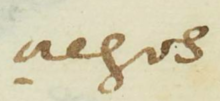popoyotl (MH608r)
Drawing from the gloss (ciegos, Spanish for blind people) and other examples of blind people in this hieroglyph database, we are tentatively calling this simplex glyph "popoyotl" (a blind person). It is a profile view of a man (Pedro Cuauhtli), looking toward the viewer's right. Black scribbling covers his visible eye.
Stephanie Wood
This glyph is just one blind person out of more than one, given the plural, ciegos. It is sad to think that there were at least two blind people in one small community. The contextualizing image shows another blind person below this one. This other man was named Felipe Nauhyotepi.
One wonders if the epidemics that ravaged early Mexico left people blinded. One cause of blindness is trachoma. Mexico eliminated this disease in recent years, according to the Pan American Health Organization. (See: https://www3.paho.org/hq/index.php?option=com_content&view=article&id=13...)
Stephanie Wood
çiegos
ciegos
1560
Jeff Haskett-Wood
blind, blinded, ciegos, nauhyotl

popoyo(tl), a blind person, https://nahuatl.wired-humanities.org/content/popoyotl
ixcocoxqui, a blind person, https://nahuatl.wired-humanities.org/content/ixcocoxqui
el ciego
Stephanie Wood
Matrícula de Huexotzinco, folio 608r, World Digital Library, https://www.loc.gov/resource/gdcwdl.wdl_15282/?sp=298st=image.
This manuscript is hosted by the Library of Congress and the World Digital Library; used here with the Creative Commons, “Attribution-NonCommercial-ShareAlike 3.0 License” (CC-BY-NC-SAq 3.0).



